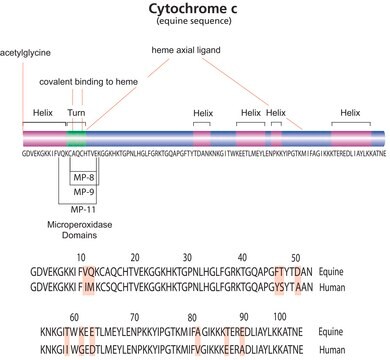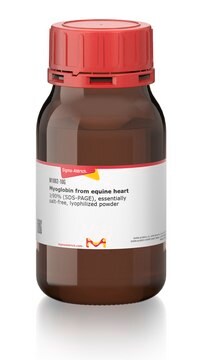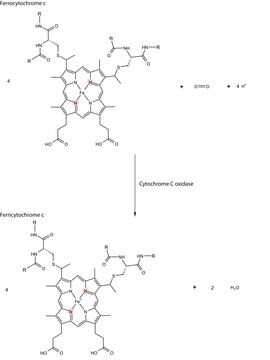C2867
Cytochrom c aus Pferdeherz
BioUltra, ≥99% (SDS-PAGE), powder, suitable for mammalian cell culture
Synonym(e):
Cytochrom c aus Pferdeherz
About This Item
Empfohlene Produkte
Biologische Quelle
horse heart
Qualitätsniveau
Produktlinie
BioUltra
Assay
≥99% (SDS-PAGE)
Form
powder
Mol-Gew.
12,384
Lagerbedingungen
(Tightly closed Dry)
Methode(n)
cell culture | mammalian: suitable
Löslichkeit
water: 10 mg/mL, dark red-brown
UniProt-Hinterlegungsnummer
Lagertemp.
−20°C
Angaben zum Gen
horse ... CYCS(100053958)
Suchen Sie nach ähnlichen Produkten? Aufrufen Leitfaden zum Produktvergleich
Verwandte Kategorien
Allgemeine Beschreibung
Research area: Apoptosis
Anwendung
Biochem./physiol. Wirkung
Angaben zur Herstellung
Sonstige Hinweise
Anwendung
Lagerklassenschlüssel
11 - Combustible Solids
WGK
WGK 3
Flammpunkt (°F)
Not applicable
Flammpunkt (°C)
Not applicable
Persönliche Schutzausrüstung
Eyeshields, Gloves, type N95 (US)
Analysenzertifikate (COA)
Suchen Sie nach Analysenzertifikate (COA), indem Sie die Lot-/Chargennummer des Produkts eingeben. Lot- und Chargennummern sind auf dem Produktetikett hinter den Wörtern ‘Lot’ oder ‘Batch’ (Lot oder Charge) zu finden.
Besitzen Sie dieses Produkt bereits?
In der Dokumentenbibliothek finden Sie die Dokumentation zu den Produkten, die Sie kürzlich erworben haben.
Kunden haben sich ebenfalls angesehen
Artikel
Learn about the four membrane-bound protein complexes that make up the electron transport chain metabolic pathway supplying energy as ATP for cellular respiration.
Chromatograms
application for HPLCapplication for HPLCapplication for HPLCUnser Team von Wissenschaftlern verfügt über Erfahrung in allen Forschungsbereichen einschließlich Life Science, Materialwissenschaften, chemischer Synthese, Chromatographie, Analytik und vielen mehr..
Setzen Sie sich mit dem technischen Dienst in Verbindung.







